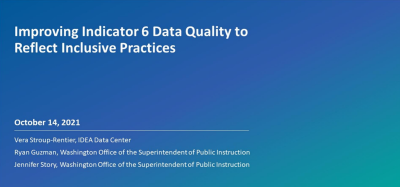Site Search
Results 29 - 35 of 39
-
Improving Indicator 6 Data Quality to Reflect Inclusive Practices
IDC and staff from the state of Washington held a discussion on improving Indicator 6 data quality. IDC provided an overview of 618 Child Count and Educational Environments data and Indicator 6. Washington state staff described the coaching they provided to regional and district staff to help them better understand, improve, and use Indicator 6 data to promote more inclusive educational environments for preschoolers with disabilities. These efforts have created changes at both the system and district levels.
Format: Guides and Briefs
2020 Part B FFY 2018 SPP/APR Indicator Analysis BookletThe 2020 Part B FFY 2018 SPP/APR Indicator Analysis Booklet presents a national quantitative picture of the implementation of Part B of IDEA based on a review of information 60 states and agencies (i.e., the 50 states, commonwealths, territories, and the Bureau of Indian Education) reported in the FFY 2018 APRs and amended SPPs they submitted to OSEP in spring 2020. For the purposes of the report, the term “state” is used for both states and other jurisdictions. The report covers Part B Indicators 1 through 17.
Format: Applications and Spreadsheets
618 Data Collection CalendarWho doesn't love a good calendar? This tool serves as a reference for states as they plan for the timely and accurate submission of their 618 data collections. Simply select a month to view the data collection and corresponding tasks and activities for that month, or select a report to view a monthly breakdown of activities and related resources.
Format: Guides and Briefs
Graduation Rate and Dropout Rate: Indicators 1 and 2 Measurement Changes From FFY 2019 to FFY 2020–2025This resource focuses on recent changes in the data source and measurement of Part B Indicators 1 and 2. The resource specifically addresses the treatment of “alternate diploma” in the new calculation. In FFY 2019, the calculation of graduation rate included students receiving an alternate diploma in the numerator. For FFY 2020–2025 the calculation of graduation rate includes students receiving an alternate diploma in the denominator. The calculation for Indicator 2 remains similar from FFY 2019 to FFY 2020–2025; however, it explicitly adds students receiving an alternate diploma in the denominator.
Format: Guides and Briefs
Statewide Assessment: Indicator 3 Measurement Changes From FFY 2019 to FFY 2020–2025This resource offers a side-by-side comparison of the SPP/APR Part B indicator measurement tables for FFY 2019 and FFY 2020 to highlight new SPP/APR reporting requirements and measurement changes to Indicator 3. The majority of students with disabilities participate in regular statewide assessments, and a small percentage of students with the most significant disabilities participate in alternate assessments. In FFY 2020, OSEP requires states to disaggregate statewide assessment results for these two groups of students with disabilities (i.e., those who participate in the regular assessment and those who participate in the alternate assessment). OSEP also requires states to calculate a “proficiency rate gap” between students with and without disabilities who participate in the regular statewide assessment.
Format: Applications and Spreadsheets
Graduation Rate (Indicator 1) and Dropout Rate (Indicator 2) CalculatorThis tool from IDC and NTACT calculates graduation and dropout rates using the 618 Exiting data, as OSEP will require in coming years for reporting in states’ SPP/APRs. The tool can accumulate and graph multiple years of data, allowing users to observe trends in the rates over time and share the information easily with stakeholders.
Format: Toolkits
LEA Data Processes ToolkitThere is a continuous need for state education agencies (SEAs) and local education agencies (LEAs) to collect and report comprehensive, high-quality data and ensure they report data accurately and in a timely fashion. The customizable IDC LEA Data Processes Toolkit is a new instrument that can improve decisionmaking about children and youth with disabilities by ensuring data are of high quality and processes are clearly defined and documented, while also providing data staff a map for documenting data processes within local districts.








